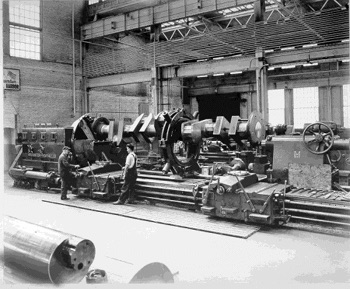The partnership of James Hemphill, W. S. Mackintosh and W. N. Hart, operating as Mackintosh, Hemphill & Co., opened a Pittsburgh machine shop where they made steam engines and other products. They later incorporated as the Mackintosh-Hemphill Co.
 |
| Mackintosh-Hemphill lathe in their own shop |
By the late 1870s, Mackintosh-Hemphill had expanded considerably and increasingly specialized in outfitting steel rolling mills, and they were responsible for outfitting many, if not most, of the Pittsburgh-area steel mills. Over the decades they made metalworking machines of interest to us here, including very large lathes. In their later years they specialized in making large rolls. The company was acquired by E. W. Bliss Co. in 1955, and then in 1968 it became a division of Gulf and Western Industries. In 1985 the foundry closed its doors; in '87 they filed for bankruptcy and the business shut down for good. Many of their buildings were demolished. In 1991 the surviving large foundry building was designated by the City of Pittsburgh as an historic structure.
Information Sources
- American Steam Engine Builders: 1800-1900 by Kenneth L. Cope, 2006 page 149
- From a Penn State University Libraries page.
In 1859 James Hemphill, W. S. Mackintosh, and W. N. Hart entered into a partnership to purchase a machine shop at the corner of 12th Street and Pike Street in Pittsburgh, Pennsylvania. Their products included steam engines. They subsequently incorporated as Mackintosh-Hemphill Company, Ltd. In 1878 the company purchased the adjoining Fort Pitt Foundry and refitted it for the manufacture of rolling mills for iron and steel makers, including the Bessemer Works in the Homestead section of Pittsburgh. In 1922 A. Garrison and Company and the Pittsburgh Iron and Steel Foundries were merged into Mackintosh-Hemphill. The E. W. Bliss Company acquired Mackintosh-Hemphill in 1955. In 1968 Mackintosh-Hemphill became a division of Gulf and Western Industries. In 1985 the foundry closed. In 1987 Mackintosh-Hemphill filed for bankruptcy and terminated its pension plan. The manufacturing buildings were demolished, but the surviving foundry buildings were designated historic structures in 1991.